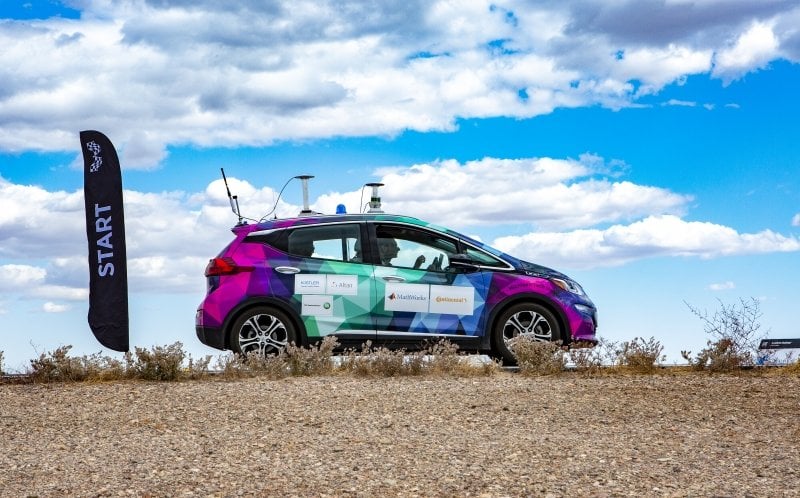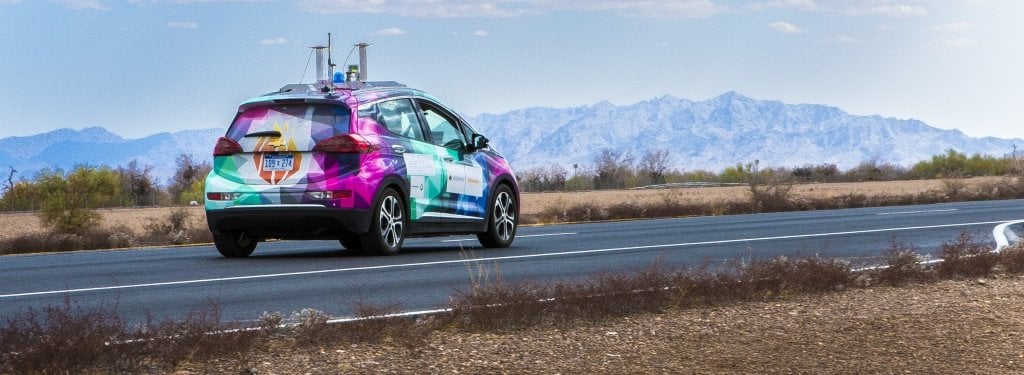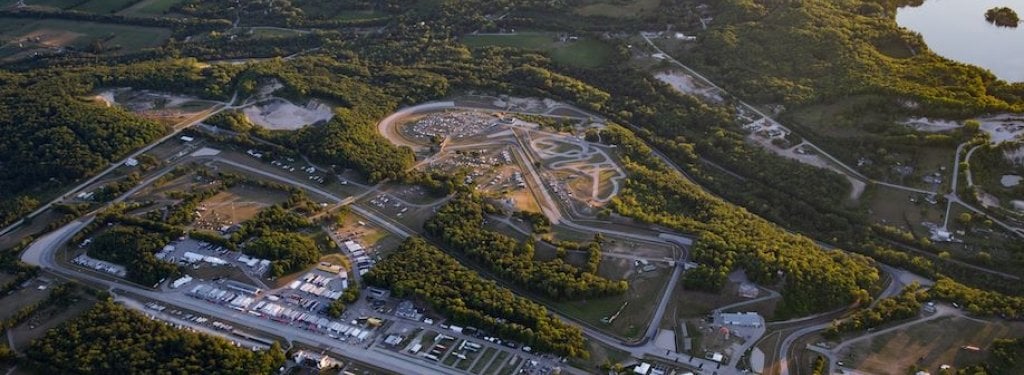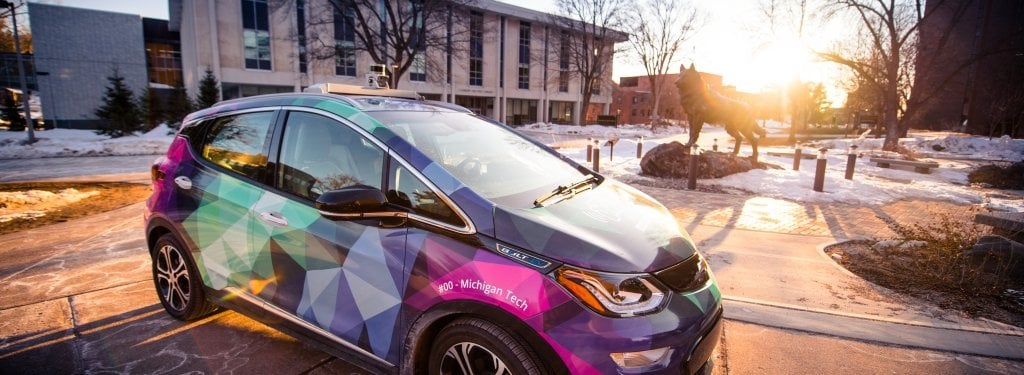Michigan Technological University is one of eight teams selected to compete in the AutoDrive Challenge. The autonomous vehicle competition kicked off April 30 down in Arizona.
Named for the Greek deities of knowledge, learning and the north wind, Michigan Tech's Prometheus Borealis team placed second in concept design and eighth overall in the inaugural competition of the AutoDrive Challenge, a three-year collegiate design competition sponsored by SAE International and GM.
Despite many days of snow-covered roads in the Upper Peninsula while the team's autonomous vehicle was in development, the Prometheus Borealis team was ready for Yuma, Arizona's heat and sun. They refined their tech at the Advanced Power Systems Labs (APS LABS), tested their vehicle at RoadAmerica in March and considered the impacts of autonomous electric vehicles on rural communities. Underneath the car's Northern Lights-inspired exterior, the four graduate students and 50-plus undergraduates on the Prometheus Borealis team engineered what really drives the project—the hardware and the software.

Autonomy starts with hardware
The APS LABS smells like new tires, cold concrete and a whiff of fuel. At first glance, it looks like a mechanic's garage—but it's bigger and there are a couple hints that this isn't tech used for an everyday oil change. A giant tire attached to an even bigger axle—no vehicle—rests on a huge bed of sand. A long workbench houses wires and circuits and fine-tipped tools. A computer screen flares with a combustion simulation.
A line of cars park along the west wall. One is clearly unique. A small hatchback in pink, navy and mint, the hood sports its purpose—"Design. Integrate. Automate." The roof rack holds up sensors; a camera peers through the front windshield; a heavy computer server rests under the floor in the back.
Derek Chopp and Akhil Kurup are two of the electrical and computer science graduate students overseeing the car's development. They explain that the car's add-on autonomy hardware is what the vehicle uses to sense the world around it.
The puck-sized cylinder on the roof rack is a Velodyne VLP-16 LIDAR system; it shoots out a laser pulse, using the speed of light to calculate distance and register key data points like road signs and obstacles. Next to it, the gray box is a NovaTel PowerPak 7-E1 GPS unit. The red box off to the side of the rearview mirror is a DFK 33UX250 USB 3.0 color camera; like the engineering equivalent of coloring in the lines, the camera scans visual data in front of the car, notably lane lines.
"For humans, this is a lot of information we already know after taking basic driver's training—double yellow means don't cross—but a vehicle doesn't inherently know that so we have to program it in," Chopp says.
And Kurup adds that safety and computational power is built on smart redundancy.
"We never rely on one sensor for one particular job, we have a collection of sensors that all contribute," he says. "So even if there is one point of failure, then the system can signal the driver to take over or, if it's small enough, then the system can adjust itself."
The data-crunching power behind the car—what truly makes it autonomous—is the intricate software systems that pull in, analyze and act on data gleaned from the hardware.
Software is the brain of a self-driving car
The terms "driverless" or "self-driving" are a bit misleading; there are six different levels of autonomy outlined by SAE International in standard J3016 and humans play a role in all of them, whether as emergency drivers or designers. At its root, autonomy means enhanced sensing (hardware) and decision-making (software). The AutoDrive Challenge teams are tasked with building a level 4 autonomous vehicle using a 2017 Chevy Volt over three years; each year the teams are tested on their speed, precision, ride quality and design. To meet that challenge, sensors help the car interface with the world while its algorithms and software, called planners, are the interface that makes sense of the world.
"From the software standpoint, we start with the vehicle interface and how it talks to the real world," Chopp explains. "For us, that's a module that runs real-time controllers, both how the vehicle should be operating and feedback from the vehicle itself."
The central communication hub is called the controller area network (CAN) and the motion planner controls the dynamics of the vehicle. The front wheels get torque commands regulating acceleration; the steering wheel gets directions based on incoming data and speed; the brakes get told when and how hard to stop.
"When the car is working well, it obeys all laws—something that some humans don't do. If you've ever rolled through a stop sign, that's something an autonomous car is not going to do because it follows the law to the T and hopefully that will create a much safer driving environment for everyone," Chopp says. "As the technology develops, and as the algorithms get better, we'll see autonomy get to the point that a driverless car is going to be safer than a human driver."
Participating in that development is a unique part of the AutoDrive Challenge. The team's advisor Jeremy Bos, assistant professor of computer and electrical engineering, says the competition is more like real industry work than a traditional class project.
"What the AutoDrive Challenge provides students is a chance to learn about what's happening in the automotive industry right now," Bos says. "They're seeing those changes and reacting to those changes in real-time in the competition; these are not ideas taught in class because the curriculum hasn't had time to catch up."
To keep up with the student crew, check out the Prometheus Borealis project on Facebook and on Twitter @MTUAutoDrive. Stay tuned for the second-year competition of the AutoDrive Challenge next year.
"I think autonomy is the future. And it has to start somewhere. So these small steps that we students are taking is eventually going to lead to something bigger."
Michigan Technological University is an R1 public research university founded in 1885 in Houghton, and is home to nearly 7,500 students from more than 60 countries around the world. Consistently ranked among the best universities in the country for return on investment, Michigan's flagship technological university offers more than 185 undergraduate and graduate degree programs in science and technology, engineering, computing, forestry, business, health professions, humanities, mathematics, social sciences, and the arts. The rural campus is situated just miles from Lake Superior in Michigan's Upper Peninsula, offering year-round opportunities for outdoor adventure.






Comments